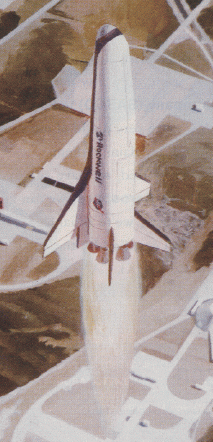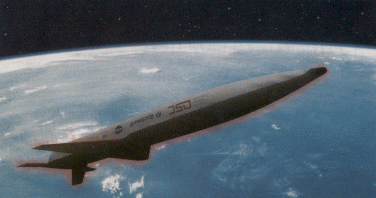
The X-33 SSTO Spacecraft
How do we cope with this? Difficult! We have to completely change our way of doing things, fire people, and let's face it, do less. On the bright side of this (that is, as long as you get to keep your job) is that we get to try new things. One of those new things, besides not embarking on planetary probes that require a lifetime and several acts of Congress to complete, is trying to replace our fleet of converted ICBMs and aging space shuttles with some spiffy new launch vehicles.
Enter the X-33 and X-34.
The X-33 is a Single Stage To Orbit (SSTO), we hope, vehicle. The two top contractors are Boeing Commercial Airplane Division, and the Rockwell skunkworks. This is by far the most challenging of the proposed new wonder vehicles.

If any of you know some basic physics, and have done some basic calculations, a SSTO requires about 98% of the total vehicle mass to be high energy propellant. In other words, payload, structure, and any propellant you need to change your orbit to one that intersects the atmosphere, and hence return home, can only account for about 2% of the space craft's mass. In other words, if your total mass to orbit is 50,000 kg (kilograms), you need about 2,500,000 kg of propellent!
As you can see this is no small feat. The only thing that gives me hope is that the engineers at Boeing think they can do it. They usually know what can be done, and what will sell. Lockheed on other hand will make any kludge fly as long as the government keeps shelling out the bucks.
The requirements are that the vehicles deliver about 10,000 kg to a space station orbit, and return in one piece. The government will pay for 1/3 of development and the company gets to pick up the rest of the tab. The reward for all this is the company has rights to sell and operate the craft at rates that will make spaceflight merely extremely expensive, as opposed to astronomically expensive.
The X-34 is a more modest effort. Orbital Sciences is already developing this vehicle. It is not SSTO. It is launched off the bottom of an L-1011 or the top of an 747. It then boosts itself to a suborbital trajectory. While outside the atmosphere it releases the payload that is attached to a small booster, and completes the acceleration to orbit. Payload to orbit is set at 500 kg. First flight is planned for 1998.

If any of these efforts pay off (and it looks like Orbital Sciences is right on) it will revolutionize space flight. Space operations will be able to shift from a all-government operation, to private operations (which will probably still depend on some sort of government subsidy).
If they don't, learn Unix--your skills will be in higher demand.
 |
 |